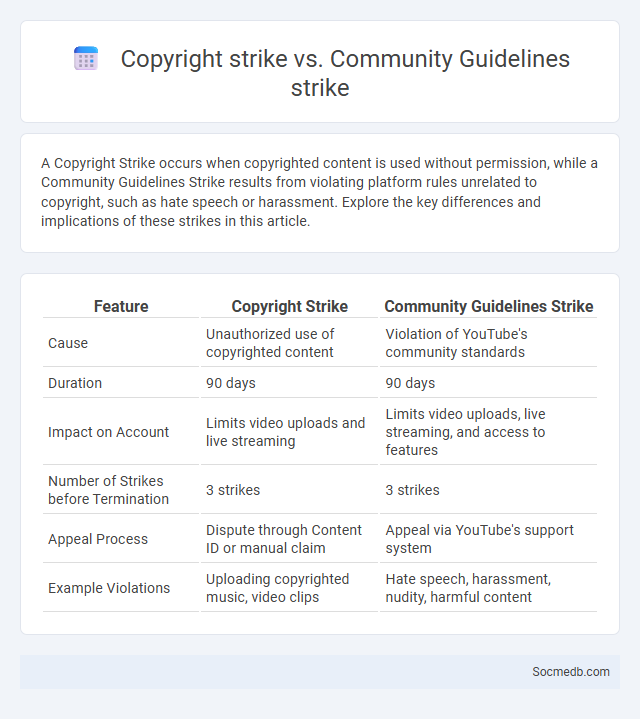
Photo illustration: Copyright strike vs Community Guidelines strike
A Copyright Strike occurs when copyrighted content is used without permission, while a Community Guidelines Strike results from violating platform rules unrelated to copyright, such as hate speech or harassment. Explore the key differences and implications of these strikes in this article.
Table of Comparison
| Feature | Copyright Strike | Community Guidelines Strike |
|---|---|---|
| Cause | Unauthorized use of copyrighted content | Violation of YouTube's community standards |
| Duration | 90 days | 90 days |
| Impact on Account | Limits video uploads and live streaming | Limits video uploads, live streaming, and access to features |
| Number of Strikes before Termination | 3 strikes | 3 strikes |
| Appeal Process | Dispute through Content ID or manual claim | Appeal via YouTube's support system |
| Example Violations | Uploading copyrighted music, video clips | Hate speech, harassment, nudity, harmful content |
Understanding Copyright Strikes: Definition and Scope
Copyright strikes on social media occur when a user uploads content that infringes on someone else's intellectual property rights, leading to platform enforcement actions such as content removal or account suspension. These strikes are enforced under policies from platforms like YouTube, Facebook, and Instagram, which use automated detection systems and manual reviews to identify violations. Understanding the scope includes recognizing that repeated copyright strikes can result in permanent bans and that fair use exceptions are limited and highly specific.
What Are Community Guidelines Strikes?
Community guidelines strikes are enforcement actions taken by social media platforms when your content violates their established rules, resulting in temporary or permanent restrictions on your account. These strikes serve to warn users and maintain a safe, respectful online environment by penalizing behaviors such as hate speech, misinformation, or copyright infringement. Understanding how strikes impact your account can help you navigate platform policies and avoid further penalties.
Key Differences Between Copyright and Community Guidelines Strikes
Copyright strikes occur when content violates legal ownership rights, leading to content removal or account penalties by platforms such as YouTube or Facebook. Community guidelines strikes result from breaches of platform-specific rules, like hate speech or harassment, and can cause temporary suspensions or feature restrictions. Understanding these distinctions helps creators properly address violations and maintain compliance with both legal standards and platform policies.
How the Strike System Works on Major Platforms
The strike system on major social media platforms enforces community guidelines by issuing warnings or penalties for violations such as inappropriate content or harassment. Each strike accumulates over a set period, leading to escalating consequences like temporary account suspension, reduced visibility, or permanent bans. Platforms such as Facebook, YouTube, and Instagram provide users with clear violation notices and an appeal process to maintain fair enforcement.
Common Reasons for Receiving a Copyright Strike
Common reasons for receiving a copyright strike on social media include unauthorized use of copyrighted music, videos, or images without proper permission or licenses. Uploading content that replicates or closely resembles copyrighted material, such as movie clips, TV shows, or music tracks, frequently triggers copyright enforcement mechanisms. Repeated violations often result in account penalties, content removal, or even suspension by platforms like YouTube, Instagram, and Facebook.
Typical Violations Leading to Community Guidelines Strikes
Typical violations leading to community guidelines strikes on social media include posting harmful or hateful content, sharing misinformation, and engaging in harassment or bullying. Violating intellectual property rights by uploading copyrighted material without permission also results in strikes. Ensuring your content complies with platform rules helps protect your account from penalties and maintain a positive online presence.
Consequences of Accumulating Strikes on Your Channel
Accumulating strikes on your social media channel significantly limits content visibility and can result in temporary restrictions or permanent bans. Each strike decreases your channel's credibility, reducing follower engagement and potential revenue streams. Repeated violations may lead to irreversible account termination, impacting long-term brand reputation and audience trust.
Steps to Appeal a Copyright or Community Guidelines Strike
To appeal a copyright or community guidelines strike on social media, start by carefully reviewing the platform's specific policies and the reason for the strike. Submit a detailed appeal form, providing clear evidence or context that supports your case, such as proof of ownership or fair use justification. Monitor the appeal status regularly and be prepared to comply with follow-up requests or escalate the issue through official support channels if necessary.
Best Practices to Avoid Receiving Strikes
To avoid receiving strikes on social media, you should consistently follow platform-specific community guidelines and avoid sharing content that violates copyright, promotes hate speech, or contains misinformation. Engaging with verified sources and using appropriate content disclaimers can help protect your account's integrity. Monitoring feedback and promptly addressing any reported issues ensures your content remains compliant and your social media presence stays safe.
Impact of the Strike System on Content Creators
The Strike System significantly affects content creators by enforcing strict penalties for guideline violations, which can limit Your ability to monetize and share content freely. Repeated infractions may lead to channel suspensions or permanent bans, disrupting Your audience engagement and revenue streams. Understanding and adhering to platform policies is crucial for maintaining a stable presence and fostering long-term growth in the competitive social media landscape.
 socmedb.com
socmedb.com